Star spectra - Study guides, Class notes & Summaries
Looking for the best study guides, study notes and summaries about Star spectra? On this page you'll find 89 study documents about Star spectra.
Page 3 out of 89 results
Sort by

-
ASTR 102 Quiz Questions | 100% Correct Answers | Verified | Latest 2024 Version
- Exam (elaborations) • 21 pages • 2024
-
- $10.49
- + learn more
We have learned that the centre of the milky way contains a very massive black hole. We developed this understanding by: - Monitoring the orbital motions of many individual stars in the very central parts of the Milky Way If the sun were to be squashed down small enough to become a black hole, then: - The planets in the solar system would orbit the Sun in unchanged fashion (but would receive no light from it) The first stellar mass black hole identified, Cygnus X-1, was found in 1973. The n...

-
ASTR 102 Quiz Questions | 100% Correct Answers | Verified | Latest 2024 Version
- Exam (elaborations) • 21 pages • 2024
-
Available in package deal
-
- $10.12
- + learn more
ASTR 102 Quiz Questions | 100% Correct Answers | Verified | Latest 2024 Version We have learned that the centre of the milky way contains a very massive black hole. We developed this understanding by: - Monitoring the orbital motions of many individual stars in the very central parts of the Milky Way If the sun were to be squashed down small enough to become a black hole, then: - The planets in the solar system would orbit the Sun in unchanged fashion (but would receive no light from it)...

-
Astro 102 Final Exam Ultimate Study Guide | 100% Correct Answers | Verified | Latest 2024 Version
- Exam (elaborations) • 26 pages • 2024
-
Available in package deal
-
- $10.12
- + learn more
Astro 102 Final Exam Ultimate Study Guide | 100% Correct Answers | Verified | Latest 2024 Version What are the characteristics of disk stars (yellow) of the Milky Way Galaxy? - High mass stars, the Sun, youngest stars, and stars that all orbit in nearly the same plane What are the characteristics of halo stars (green) of the Milky Way Galaxy? - Globular clusters, oldest stars, stars whose orbits can be inclined at any angle, and stars with smallest abundance of heavy elements. Wh...

-
Astronomy Chapter 5 Written Exam Questions & Answers.
- Exam (elaborations) • 3 pages • 2024
-
Available in package deal
-
- $11.49
- + learn more
Astronomy Chapter 5 Written Exam Questions & Answers. Suppose you see two stars: a blue star and a red star. Which of the following can you conclude about the two stars? Assume that no Doppler shifts are involved. (Hint: Think about the laws of thermal radiation.) - CORRECT ANSWER The blue star has a hotter surface temperature than the red star. From lowest energy to highest energy, which of the following correctly orders the different categories of electromagnetic radiation? - CORRECT ANS...
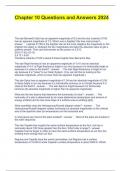
-
Chapter 10 Questions and Answers 2024
- Exam (elaborations) • 4 pages • 2024
-
Available in package deal
-
- $12.99
- + learn more
Chapter 10 Questions and Answers 2024 The star Bernard's Star has an apparent magnitude of 9.5 and the star Lelande 21185 has an apparent magnitude of 7.5. Which one is brighter? By how many times? Lelande 21185 is the brighter star as the more negative the magnitude is, the brighter the object is. Subtract the two magnitudes and take the absolute value to get a positive answer. Then use that answer as the power on 2.512. |9.5-(+7.5)| =2| =2| 2.5 ^2 = 6.25 Therefore Lelande 21185 is about ...
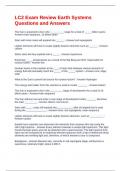
-
LC2 Exam Review Earth Systems Questions and Answers
- Exam (elaborations) • 2 pages • 2024
-
Available in package deal
-
- $8.49
- + learn more
The Sun is expected to be in the __________ stage for a total of _____ billion years - Answer-main sequence, 10 billion years Stars with more mass will expand into ______ - Answer-red supergiants Lighter elements will fuse to create slightly heavier elements such as ______ - Answer-carbon When stars die they explode into a _____ - Answer-supernova Extremely_____ temperatures as a result of the Big Bang are NOT responsible for nuclear fusion - Answer-low Nuclear fusion is the react...
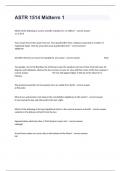
-
ASTR 1514 Midterm 1 Exam With Questions And Correct Answers Graded A+.
- Exam (elaborations) • 6 pages • 2024
-
- $12.99
- + learn more
Which of the following is correct scientific notation for 1.5 million? - correct answer 1.5 x 10^6 Your cousin lives 10 km away from you. Your grandmother lives a distance away that is 3 orders of magnitude larger. How far away does your grandmother live? - correct answer 10000 km Scientific theories can never be changed for any reason - correct answer ...
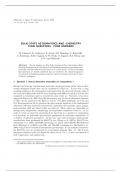
-
SOLID STATE ASTROPHYSICS AND-CHEMISTRY FOUR QUESTIONS- FOUR ANSWERS
- Exam (elaborations) • 6 pages • 2024
-
- $14.99
- + learn more
SOLID STATE ASTROPHYSICS AND-CHEMISTRY FOUR QUESTIONS- FOUR ANSWERS H. Linnartz, K. Acharyya, Z. Awad, S.E. Bisschop, S. Bottinelli, J. Bouwman, H.M. Cuppen, G.W. Fuchs, S. Ioppolo, K.I. ¨ Oberg and E.F. van Dishoeck1 Abstract. Recent progress in ultra high vacuum surface experiments allows detailed investigations of the physical and chemical parameters governing astro nomically relevant solid state processes on icy dust grains. In this proceeding four questions are shortly addre...
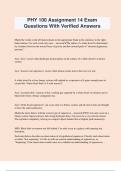
-
PHY 100 Assignment 14 Exam Questions With Verified Answers
- Exam (elaborations) • 10 pages • 2024
-
- $12.49
- + learn more
PHY 100 Assignment 14 Exam Questions With Verified Answers Match the words in the left-hand column to the appropriate blank in the sentences in the right- hand column. Use each word only once. - answerThe radius of a white dwarf is determined by a balance between the inward force of gravity and the outward push of "electron degeneracy pressure." A(n) "nova" occurs when hydrogen fusion ignites on the surface of a white dwarf in a binary system. A(n) "massive star supernova" occurs w...
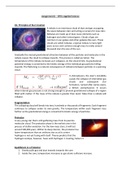
-
Unit 16 Assignment D
- Summary • 13 pages • 2022
-
Available in package deal
-
- $9.13
- 9x sold
- + learn more
Unit 16 Assignment D Overall Grade: Distinction Course Overall Grade: D*D Contains: Star creation, astrophysics, fragmentation, protostars, initial nuclear reactions, sequence stars, life cycle, spectral energy, core collapse, supernovae, neutron stars, black hole, magnitude, black body radiation, HRs, stellar spectra, the Doppler effect, parralax, cepheid variables, eclipse, the Big Bang theory, red shifts, microwaves, Hubble's Law, forming galaxies, Quasars, Obler's paradox, Alien lif...

$6.50 for your textbook summary multiplied by 100 fellow students... Do the math: that's a lot of money! Don't be a thief of your own wallet and start uploading yours now. Discover all about earning on Stuvia


